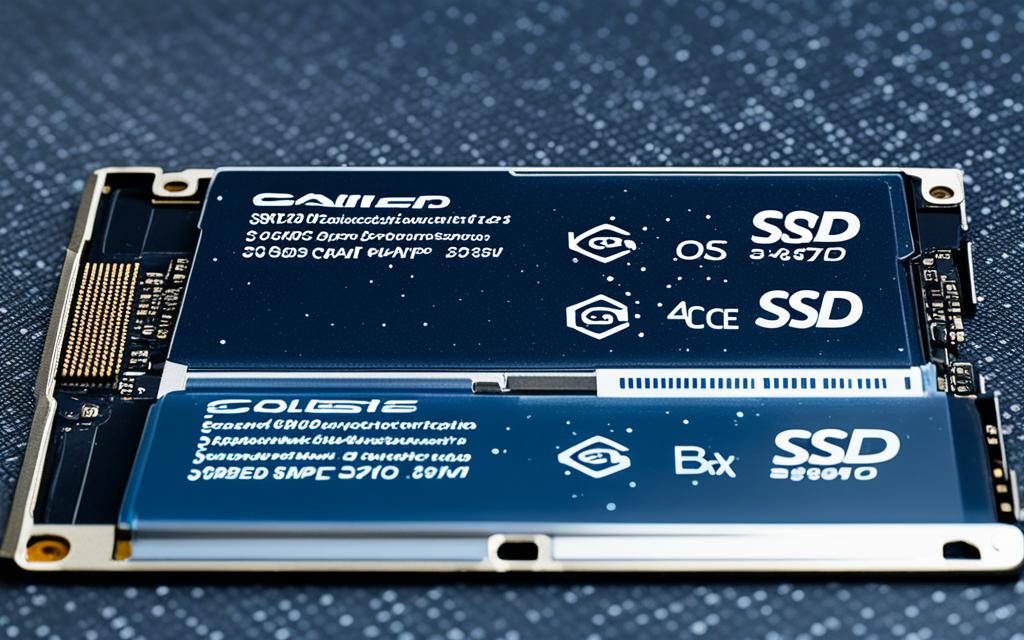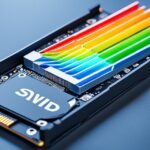Table of Contents
Many wonder if solid-state drives (SSDs) slow down as they get full. These devices are favoured for their quick data speed and SSD efficiency. But, as they fill up, some worry about how it impacts their ability to write data quickly. This concern is especially key for those who game or use demanding software. It’s crucial to tackle myths about SSDs losing speed as they fill up. Reports do say SSDs might slow a bit when almost full1. It’s vital to understand how writing over already used sections affects speed, to keep SSDs working well1.
So, this piece explains if a full SSD really changes how your device works. It also offers tips on keeping your SSD speedy.
Key Takeaways
- SSDs may experience a slight slowdown as they fill up.
- Writing data over parts of the SSD that are not “zeroed” can greatly affect write speeds.
- Heat impacts SSD performance, potentially causing throttling.
- Periodic secure erase or low-level formatting can help restore SSD performance.
- As SSD age, they might face read slowdowns.
- Performance variability can occur across different sections of the SSD drive.
- The relationship between SSD age and performance degradation remains inconclusive.
Understanding SSD Technology
SSD technology is changing how we store data today. Unlike old-style hard drives with spinning disks, SSDs use integrated circuits. This change boosts reliability and greatly speeds up performance. It meets the high demands of present-day computing.
How SSDs Differ from Traditional Hard Drives
SSDs are different from old hard drives in several ways. They don’t have moving parts, making them less likely to break if dropped. This design results in quicker data access and faster start-up times for computers. Additionally, SSDs operate quietly, enhancing the user experience. Because of these reasons, tech fans and professionals prefer SSDs2.
The Role of Integrated Circuits in Performance
Integrated circuits are key to SSDs’ speed. They allow SSDs to handle data much faster than traditional hard drives, which use magnetic storage3. SSDs can do lots of tasks at once because they’re made up of cells, pages, and more. This setup makes them better at storing data3. Continuing improvements in SSD tech solve previous issues, making newer models even more efficient.
Common Myths about SSD Performance
It’s important to understand the myths around SSD performance to get the most out of them. Many people think SSDs slow down when full. However, modern SSDs manage data well even when nearly full. Right now, you can find SSDs with 32 TB, and soon we might see 50 TB models4. Plus, SSD prices have dropped, making them more common4.
Debunking Misconceptions on Capacity Limits
Some believe SSDs stop working well when they’re full. But high-end SSDs actually handle data smartly. Older SSDs couldn’t write as much data before. But now, they can handle around 100,000 cycles. Some even last three times as long as old hard drives5. They use clever ways to spread out the data, helping the SSD last longer5.
Performance Dynamics in Various Use Cases
Different tasks affect SSD performance in various ways. Normal users won’t see much change in speed, even when the SSD is nearly full. Games, which read a lot of data, are easier on SSDs than tasks that write a lot. The NVMe protocol makes SSDs even faster, which is great for modern systems4. Understanding how you use an SSD can clear up many myths.
Do SSDs Slow Down When They Are Full?
When SSDs get full, their performance can drop. This is especially true if more than 75% of the space is used. At this stage, writing data to the SSD slows down. This happens because the SSD has fewer empty blocks available for new data6. Having space available is key for SSDs to write data quickly. When there’s not much space left, it can cause delays.
The Impact of Capacity on Write Speeds
Studies show that a nearly full SSD can slow down a lot. When there’s little free space left, both write speeds and the system’s quickness suffer7. This can mean tasks that were once fast may start to drag out.
When is an SSD Considered Full?
An SSD is seen as full when it’s 90-100% full. At this stage, there’s a clear drop in how well it works. It’s wise to keep an eye on how full your SSD is. Try to stay under 75% full to keep things running smoothly6. Not using important features like TRIM can make things worse. This shows how crucial SSD management is7.
Reasons Behind SSD Slowdown When Full
When SSDs are fully loaded, their performance drops for several reasons. Key among these are write amplification and garbage collection troubles. Understanding these is crucial for managing your data well.
Understanding Write Amplification
Write amplification means more data gets written on the SSD than you intended. This happens because erased files don’t immediately clear up space. Thus, the SSD ends up doing extra work. When SSDs get full, their write speed can drop by almost half, even though reading data stays quick8. Performance worsens especially when more than 75% of the SSD is used. This shows the importance of keeping an eye on how much space you’re using6.
The Challenge of Garbage Collection
Garbage collection helps SSDs arrange free space. But, it struggles to work well when the SSD is almost full. Keeping at least 20% of the SSD empty ensures this system works best9. It’s critical to monitor your SSD’s speed. Any slowdown could mean trouble is near, highlighting the need for frequent data backups9.
Solutions to Mitigate Slowdown Risks
To get the best out of SSDs, knowing how to reduce slowdown risks is key. Using TRIM and good space management helps a lot.
Implementing TRIM for Peak Performance
The TRIM command plays a big role in boosting SSD speed. It lets the operating system tell the SSD which blocks of data aren’t needed anymore. This makes the SSD work more smartly and keep space in check for top performance. It’s very important to make sure TRIM is always on10.
Updating the firmware by yourself can keep the drive stable. This stops problems before they start and keeps the drive running smoothly11.
Strategies for Efficient Space Management
There are key steps to make SSD storage last longer and work better. Users should:
- Do regular clean-ups to get rid of old files and make room for new ones.
- Align partitions to 4K to boost the speeds of reading and writing data12.
- Steer clear of defragmenting, which can harm the SSD and shorten its life11.
- Set the power options correctly to avoid sudden loss of power causing data issues.
- Keep an eye on how much space is being used to manage it better over time.
By following these steps, users can make their SSDs work better and last longer.
Best Practices for SSD Maintenance
Understanding how to take care of your SSD is crucial for its longevity and performance. By doing things like updating software, keeping an eye on storage, and over-provisioning, you can have a great user experience.
Ensuring Regular Software Updates
Keeping your SSD’s software current is key for its speed and health. Updates can fix issues and boost reliability. Plus, updating firmware keeps it running well, using the latest tech and safety features13.
Monitoring Storage Levels and Performance
Watching your storage space stops the SSD from getting too full. It’s smart to keep 10-15% of the SSD’s space free14. This keeps it fast and stops major slowdowns when it’s filled up15. Noting when its speed changes tells you if it needs a fix.
Over-Provisioning: A Proactive Approach
Setting aside part of the SSD for TRIM and Garbage Collection helps a lot. Most SSDs for everyday use save around 7% of space for this14. It helps your SSD work better for longer, avoiding slowness and damage from too much use.
Conclusion
This article explored critical insights into SSD performance, focusing on how they function as they get full. We looked at how SSDs differ from traditional hard disks. This helps debunk myths about storage efficiency and the real-world performance of these devices. It’s key to know that while SSDs handle data quickly, they can slow down, especially when nearly full.
The article then discussed why SSDs might slow down, covering write amplification and garbage collection. It underlined the importance of managing your SSD well. Using tools like TRIM and regularly checking your SSD ensure it works well for longer. This means keeping your SSDs in great shape involves regular check-ups and keeping some space free.
In summarising SSD management tips, we aim to encourage users to take good care of their storage. This ensures they make the most of their SSD, avoiding slowdowns. As tech evolves, adopting these practices keeps SSD performance high, protects your data, and enhances how you use your device16.
FAQ
Do SSDs slow down when they are nearly full?
Yes, SSDs can start losing speed as they fill up, particularly past 75% capacity. This happens because of how they handle writing data and managing what’s already stored.
What is the difference between an SSD and a traditional hard drive?
SSDs use circuits to store data, making them faster and more reliable than HDDs. HDDs use spinning disks to read and write data. The lack of moving parts in SSDs means they perform better.
Are there common myths about SSDs that I should know?
Indeed, one myth is that SSDs quickly lose performance when full. However, modern SSDs are built to stay fast even when they’re nearly at capacity. This is true for most daily users.
What happens to write speeds when an SSD is full?
Write speeds drop as an SSD fills up. It becomes harder to find space for new data. This affects tasks that need quick data saving, like gaming or running big apps.
What is write amplification, and why is it relevant?
Write amplification means data writes more than once to memory cells. It occurs when deleted files don’t free up space as they should, slowing down the SSD.
How can I improve my SSD’s performance?
Activate the TRIM command for better data management. Regularly cleaning storage and preventing fullness also helps your SSD work better and last longer.
What are the best practices for maintaining SSD health?
Update your software and firmware for new performance improvements. Watching how full your SSD gets is key. Leaving some space free, known as over-provisioning, can make your SSD last longer.
Source Links
- https://www.overclock.net/threads/do-ssds-get-slower-in-read-speed-as-they-age.1778646/ – Do SSDs get slower in read speed as they age
- https://www.techtarget.com/searchstorage/definition/SSD-solid-state-drive – What is an SSD (Solid-State Drive)?
- https://www.kingston.com/en/blog/pc-performance/full-ssd-solutions – What to Do if Your SSD Is Full
- https://getprostorage.com/blog/ssd-myths-debunked/ – SSD Myths: 5 Myths About SSD Issues Debunked – ProStorage
- https://www.storagesearch.com/ssdmyths-endurance.html – SSD endurance myths and legends articles on StorageSearch.com
- https://www.partitionwizard.com/resizepartition/do-ssd-slow-down-when-full.html – Do SSD Slow Down When Full & How to Fix It? [Answered]
- https://www.minitool.com/data-recovery/ssd-slow-windows-10-fix.html – SSD Slow on Windows 10? Speed It Up & Protect Data
- https://www.easeus.com/partition-manager-software/does-ssd-get-slower-when-full.html – Does SSD Get Slower When Full? Fix SSD Slowing Down [Easy Tricks]
- https://datarecovery.com/rd/slow-performance-on-an-ssd-6-common-causes/ – Slow Performance on an SSD: 6 Common Causes – Datarecovery.com
- https://www.auslogics.com/en/articles/ssd-optimization-on-windows/ – SSD Optimization on Windows 10/11
- https://www.crucial.com/support/articles-faq-ssd/optimizing-your-ssd – Optimizing Your SSD
- https://www.easeus.com/partition-master/external-ssd-slow-write-speed.html – External SSD Slow Write Speed? Here are 4 Efficient Fixes
- https://www.easeus.com/partition-manager-software/ssd-maintenance.html – SSD Maintenance: Tips to Maintain Performance and Extend the Life of Your SSD
- https://www.slrlounge.com/tips-to-get-the-most-from-your-ssds/ – Top 7 Tips to Get the Most from your SSDs
- https://www.diskpart.com/articles/ssd-slowing-down-7201.html – SSD Slowing Down? 7 Quick Tricks to Make SSD Run Faster!
- https://www.reddit.com/r/hardware/comments/1146b0s/ssd_sequential_write_slowdowns/ – Reddit – Dive into anything








